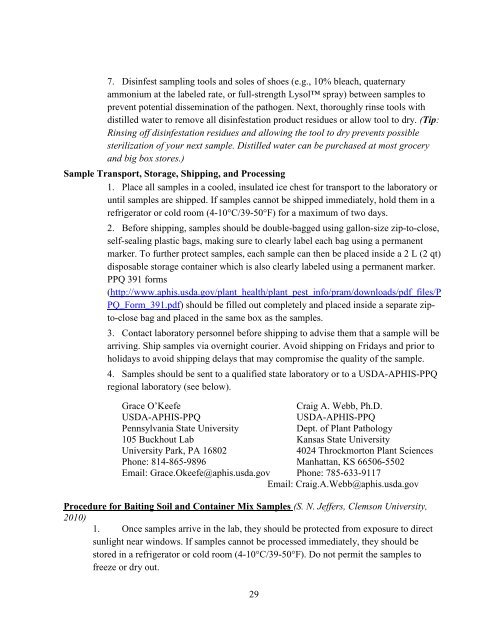Confirmed Nursery Protocol - aphis
Confirmed Nursery Protocol - aphis
Confirmed Nursery Protocol - aphis
Create successful ePaper yourself
Turn your PDF publications into a flip-book with our unique Google optimized e-Paper software.
7. Disinfest sampling tools and soles of shoes (e.g., 10% bleach, quaternary<br />
ammonium at the labeled rate, or full-strength Lysol spray) between samples to<br />
prevent potential dissemination of the pathogen. Next, thoroughly rinse tools with<br />
distilled water to remove all disinfestation product residues or allow tool to dry. (Tip:<br />
Rinsing off disinfestation residues and allowing the tool to dry prevents possible<br />
sterilization of your next sample. Distilled water can be purchased at most grocery<br />
and big box stores.)<br />
Sample Transport, Storage, Shipping, and Processing<br />
1. Place all samples in a cooled, insulated ice chest for transport to the laboratory or<br />
until samples are shipped. If samples cannot be shipped immediately, hold them in a<br />
refrigerator or cold room (4-10°C/39-50°F) for a maximum of two days.<br />
2. Before shipping, samples should be double-bagged using gallon-size zip-to-close,<br />
self-sealing plastic bags, making sure to clearly label each bag using a permanent<br />
marker. To further protect samples, each sample can then be placed inside a 2 L (2 qt)<br />
disposable storage container which is also clearly labeled using a permanent marker.<br />
PPQ 391 forms<br />
(http://www.<strong>aphis</strong>.usda.gov/plant_health/plant_pest_info/pram/downloads/pdf_files/P<br />
PQ_Form_391.pdf) should be filled out completely and placed inside a separate zipto-close<br />
bag and placed in the same box as the samples.<br />
3. Contact laboratory personnel before shipping to advise them that a sample will be<br />
arriving. Ship samples via overnight courier. Avoid shipping on Fridays and prior to<br />
holidays to avoid shipping delays that may compromise the quality of the sample.<br />
4. Samples should be sent to a qualified state laboratory or to a USDA-APHIS-PPQ<br />
regional laboratory (see below).<br />
Grace O’Keefe<br />
Craig A. Webb, Ph.D.<br />
USDA-APHIS-PPQ<br />
USDA-APHIS-PPQ<br />
Pennsylvania State University<br />
Dept. of Plant Pathology<br />
105 Buckhout Lab Kansas State University<br />
University Park, PA 16802<br />
4024 Throckmorton Plant Sciences<br />
Phone: 814-865-9896 Manhattan, KS 66506-5502<br />
Email: Grace.Okeefe@<strong>aphis</strong>.usda.gov Phone: 785-633-9117<br />
Email: Craig.A.Webb@<strong>aphis</strong>.usda.gov<br />
Procedure for Baiting Soil and Container Mix Samples (S. N. Jeffers, Clemson University,<br />
2010)<br />
1. Once samples arrive in the lab, they should be protected from exposure to direct<br />
sunlight near windows. If samples cannot be processed immediately, they should be<br />
stored in a refrigerator or cold room (4-10°C/39-50°F). Do not permit the samples to<br />
freeze or dry out.<br />
29
















